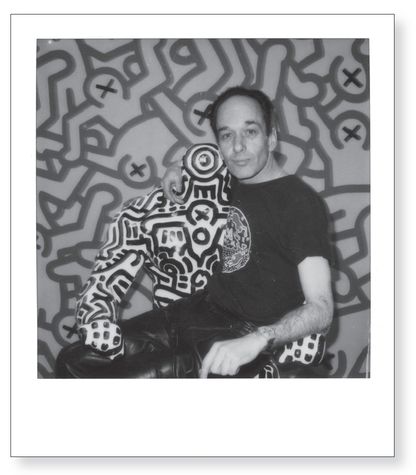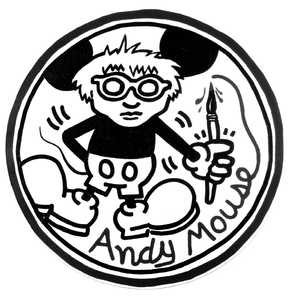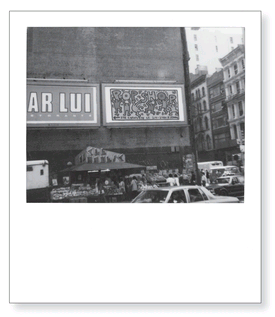Keith Haring Journals (22 page)
Read Keith Haring Journals Online
Authors: Keith Haring

Bobby was a saint that was sent as a messenger and protector, like Jiminy Cricket to Pinocchio. He knew everybody and introduced me to other key people in my life, like Grace Jones and Larry Levan. It wasn’t so much Bobby’s introduction, but his support and endorsement that won for me the immediate respect of the people he introduced me to. He had been living in N.Y. his whole life and had been on the “scene” since the Sixties. Everyone that knew Bobby respected his opinion. He had worked with Stephen Burroughs at the height of his career in the Seventies. And then in the early 1980s he met me and adopted the role as my guide and protector. Bobby was the perfect screen to throw ideas against. His reaction, whether positive or negative, whether followed or contested, was always a very concrete reaction and very strong opinion. Although we sometimes disagreed about things, the very fact that we did disagree helped me to clarify my confidence in my opinions or decisions.
He never judged me, but often disciplined me and would not hesitate to tell me if something was in bad taste or bad manners. He would never lie to me whether he had been advised to or not. I remember on occasion Bobby sitting beside me at my desk and dialing a number and handing me the phone, before I had a chance to protest or think twice, so that I would have to speak to the person on the other line whether I liked it or not, and was forced to “thank them” or “deal with it” or “tell them what you think,” like I knew I should have in the first place.
He pushed with a strong but gentle arm, and a sharp but tactful tongue. And when he liked something he was never subtle in showing his praise. The ultimate sign of approval was the little “dances,” as Benny Soto called them, when he would enter the studio, see a painting, and jump up and down and clap his hands. “Way to go, kid.” Or “You did it again, kid.” Always encouragement and support.
And not only for me. Bobby helped many with his insight, advice, opinions, and encouragement and support. From models to designers, to artists to dancers to performers, musicians, photographers, business people, and just plain friends.
He was quick to suggest available opportunities and options and offer confidence for any projects you were considering. He made this his role in life and never complained. At the same time he was an extraordinary artist and craftsman himself. The framed letter from Diana Vreeland hanging in his apartment was a testimony to this. She said, “You are to leather what Cellini was to gold.” His leather work was incredible in design and execution. The leather “baby” he made for me was later a prototype for the “inflatable baby” we made in Hong Kong. It was incredible to arrive home to my new apartment on Sixth Avenue in December and find the new set of “Bobby Pillows” he had made to match my leather couch. It was the last thing he made for me, and they are really beautiful.
Bobby was also the guiding light behind the Pop Shop. He respected my limited interest in “making money” and understood, as I do, the aesthetic reasons for the Pop Shop’s existence. The Pop Shop is an extended “performance” and even though Bobby tried to make it “make money,” he never pushed me and never questioned my own personal goals and reasons for doing the Shop. Although our opinions differed, we understood each other and respected each other.

I remember one of the last meetings Bobby and Julia and I had before Bobby went into the hospital. We were discussing the “career-minded” goals of the manager of the Pop Shop, and his misunderstanding of my personal goals for the Pop Shop. Bobby explained that he “always had a good feeling” about my incentive for starting the Shop and “understood” why I wasn’t so interested in making money. Very few people understand why someone would want to open a shop and not make money. I don’t think Bobby had worked for anyone like that before, but he respected my attitude and went along with it. He let me know he thought I “knew what I was doing.”
Bobby had an artist’s sensibility and sensitivity. He was also my eyes and ears. He was always the first to find me in the
New York Times
and the
Post
. He was always clipping articles of interest and bringing me tapes to listen to. He could “sense” talent. One time a few years ago we went to a party at the Limelight for one of the Jacksons. There was a young singer who we had never heard before who performed. He kept telling me how great he thought she was. I wasn’t really that impressed by her, but he was really adamant about it. Well, he was right, as usual. She was Whitney Houston.
New York Times
and the
Post
. He was always clipping articles of interest and bringing me tapes to listen to. He could “sense” talent. One time a few years ago we went to a party at the Limelight for one of the Jacksons. There was a young singer who we had never heard before who performed. He kept telling me how great he thought she was. I wasn’t really that impressed by her, but he was really adamant about it. Well, he was right, as usual. She was Whitney Houston.
Losing Bobby meant a new responsibility to not only go forward without his assurances, but also to try to fill the gap he left by continuing to give support to other people that need it.
The last thing in the world I expected to hear after I left for Brazil was that Andy died.
Andy was the complement to Bobby’s support. He was the other assurance that what I was doing was on the right track. I mean, it’s not as if there aren’t any more people that support me and give me confidence, it’s just that Bobby and Andy were probably the main two.
Andy’s life and work made my work possible. Andy set the precedent for the possibility for my art to exist. He was the first
real
public artist in a holistic sense and his art and life changed the concept we have of “art and life” in the 20th century. He was the first
real
“modern artist.”
real
public artist in a holistic sense and his art and life changed the concept we have of “art and life” in the 20th century. He was the first
real
“modern artist.”
Andy was probably the only
real
Pop artist. One thing that I was most impressed by in a recent show at the Dia Foundation of the “Disaster” series was a paragraph in an accompanying pamphlet about the paintings. It was a quote from Lawrence Alloway about Pop Art, saying how in the beginning of Pop there was a breakdown and fusion of life and art (a celebration of popular culture) that was first embraced by Pop artists. Then little by little the painters withdrew from this area and took their ideas back into the form and arena of the art “establishment.” This, it said, is the point where Andy separated from the rest of the group and remained true to the original ideas of Pop Art.
real
Pop artist. One thing that I was most impressed by in a recent show at the Dia Foundation of the “Disaster” series was a paragraph in an accompanying pamphlet about the paintings. It was a quote from Lawrence Alloway about Pop Art, saying how in the beginning of Pop there was a breakdown and fusion of life and art (a celebration of popular culture) that was first embraced by Pop artists. Then little by little the painters withdrew from this area and took their ideas back into the form and arena of the art “establishment.” This, it said, is the point where Andy separated from the rest of the group and remained true to the original ideas of Pop Art.
Andy remained a Pop artist. He reinvented the idea of the life of the artist being Art itself. He challenged the whole notion of the “sacred” definition of Art. He blurred the boundaries between art and life so much that they were practically indistinguishable.
He addressed the phenomena of the camera and recorded image in a way that Duchamp only hinted at. He challenged the whole commodity-oriented direction of the Art world by beating them at their own game. He became a teacher for a generation of artists now, and in the future, who grew up on Pop, who watched television since they were born, who “understand” digital knowledge. I honestly think he was the most important artist since Picasso, whether people like it or not, and a lot of them don’t. The museum and auction worlds didn’t know how to deal with him. The “value” of his work was not equivalent to the “market value” of his works. Conceptually, he was certainly much more important than Johns or Lichtenstein, but his prices never equalled theirs because he didn’t play “the game” by the rules.

I was continually getting compared to Andy, but I don’t know if it was for the right reasons. For me, it was an honor to be compared to him even though I feel we are very different and our contributions are different.
But I will always acknowledge my debt to him. The biggest honor was the support and endorsement he bestowed upon me. By mere association he showed his support. When we began to trade works we traded value for value, but quickly as we became friends we began to trade work for work (one for one instead of disproportionate amounts). I learned a lot of things from Andy in the five years we were friends. He prepared me for the “success” that happened to me while I knew him, and taught me the “responsibility” of that success. He taught mostly by example, but would often offer ideas and suggestions, sometimes humorous and sometimes serious. During the last few years he was one of the few artists that I could really talk to about some of the things I was attempting to do. Also, he was one of the only artists whose studio would inspire me to work more and work harder. Ironically, he was the one who convinced me to be more health-conscious and aware of my body. When I was at the Factory and he could do more push-ups than me, I knew it was time to start working out. He was always interested in everything I was doing and was totally plugged in to everything that was happening around him. He didn’t, however, only take; he gave as much as or more than he took. He was the personification of New York.
It is hard to imagine what N.Y. will be like without Andy. How will anybody know where to go or what is “cool”?
Selfishly, I feel like I will lose more than most. I lost a friend, a teacher, and the biggest supporter in the real Art World.
Like Bobby, Andy was the reassurance I looked forward to for the difficult course I am charting. He set the precedent for my venture into the commercial world and the popular culture. He is the validation for a kind of “seriousness” or “realness” that is balanced on the tightrope I am walking between “high” and “low” art. His support made me oblivious to the critic cultures waiting for a wrong move and anxiously anticipated fall. His understanding was more valued than any art critic’s. Most critics only write to defend their own ideas and previous statements, anyway.
Andy practically convinced me to open the Pop Shop when I started to get cold feet. He always added his support to a new idea or venture. He further showed his support for the Pop Shop by creating a T-shirt for it and plugging it at any opportunity.
He got jobs for me, he directed collectors to me and continually traded works.
I feel like I have a responsibility to try to continue the things that he inspired and encouraged. There isn’t anyone else who can pay homage the way that I can. At least, nobody I know of now. There have to be new artists coming up somewhere, but right now there is nobody. It is not an easy venture and it will be even more difficult without Andy or Bobby, but it is worth whatever risk is involved and it is an honorable undertaking, whether it is understood now or not.

In time everything will become clearer. I hate sounding pretentious or egotistical, except that I really never thought anyone understood how to build on Andy’s achievements, except Andy, and maybe me. Not only in a formal way, but conceptually and with the same holistic approach and attitude. His visual vocabulary and technical means and especially the actual “look” of his art (his line, his “graphic” sense) determined and made possible the wide range of applications and complexity of his “art” and its integration into the popular culture. His graphic quality in painting preceded and predetermined the possibility of using the silk-screen process. Conceptually the photos, films and photo silk-screens inevitably addressed the commercial world and the mass media. He gave a philosophy to the modern value system of images. The “value” of “pictures” and images.
All of the philosophy of “fame and success” and all of the portraits and films and talk of “machine art” and “business as art” and all of the personification of what became known as Pop Art was born of his honest evolution of his early graphic sensibility. The work naturally “happened,” and the things that followed were inevitable.
Other books
Daisy Madigan's Paradise by Suzy Turner
Catering to the Italian Playboy by Tamelia Tumlin
Stacey And The Mystery At The Mall by Ann M. Martin
Canyon Sacrifice by Graham, Scott
The Christmas Violin by Buffy Andrews
Unbroken by Paula Morris
The Duke Takes a Bride (Entitled Book 2) by Suzette de Borja
Sea Wolf Magick (Highlander Magick Series Book 2) by Patty Taylor
The Fruit of My Lipstick by Shelley Adina
Wicked Charms by Janet Evanovich